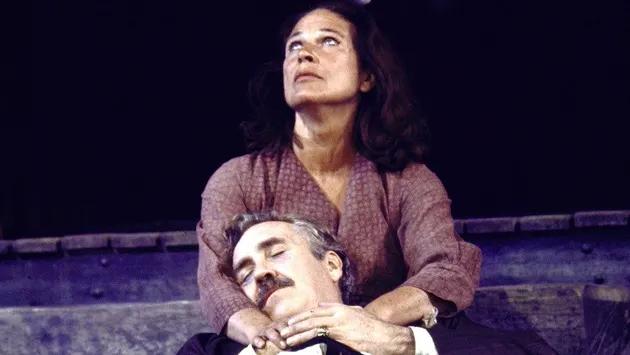.jpeg)
April 11, 2022: Theatre Yesterday and Today, by Ron Fassler
It’s a funny thing about an actor’s resume: they’re never complete and always a work in progress. In the constant act of selling themselves, an actor’s career needs continual updating. What’s usually done is that the oldest credit is removed at the bottom for every new one that is added to the top, mostly so it can all fit on the back of an 8 x 10 photo. After all, the older the show, the older you are, and no one likes dating themselves. Occasionally, you'll find an actor who wants a casting director to see everything they've ever done by squeezing the font smaller to fit a single page, but it's not a smart idea. And in the theatre, actors are in charge of composing their own bios for the program, which is another thing altogether. These days, with space becoming shorter, it poses challenges. I’ll never forget an email a few years back from a friend crying out, “I’ve been given eighty characters to write my bio and I’ve been in the business forty years. That’s two words for every year. Help!”
Conversely, when an actor is just starting out, some general padding is often necessary. If someone is fortunate enough to get an early break, how do they fill their bio? No one wants to list their college credits when making a Broadway debut, leaving room for a little creativity. So, in the interest of fun, I did some research for this column and buried through my Playbills collection for some early bios of actors who had to dig deep to find something to write about.
When he co-starred in 1961’s The Unsinkable Molly Brown, the splendid actor/singer Harve Presnell was a twenty-six-year-old Californian with mostly opera credits. In his Playbill bio, he spends a lot of time discussing his training and listing famous names he shared the stage with at concerts, like Leontyne Price, leaving additional space for Presnell to treat audiences to read about his upbringing: “He spent his youth on the family ranch near Yosemite Valley where he herded cattle, worked horses, labored in the field, drove a tractor,” making for a refreshing read what with limitations placed on space in Playbill today.

Talking about your family is another sort of space filler. Tony Award winner Reed Birney didn’t have many credits when he made his Broadway debut in 1977 in Albert Innaurato’s Gemini (“I’m not hungry, I’ll just pick”), so, Birney ended his short bio with this: “The son of a terrific and warm Episcopalian minister father and a wonderful and funny typing teacher mother, Reed has three brothers, a sister, and two sisters-in-law, has his roots in Delaware, and is delighted to be playing tonight in Gemini.” It’s possible this is the only time someone’s sisters-in-law made it into a Playbill bio (Reed’s a friend, so I can tease).
In 1970, with only regional theatre and television commercials to his credit, Charles Kimbrough (famous years later for his ten seasons as Jim Dial on CBS’s Murphy Brown), chose to include the following in his bio when he created the role of Harry in a certain Sondheim musical: “Harold Prince saw him in his Broadway debut in Cop-Out, and said after the performance — “I want you for Company.’” It's wonderful of Kimbrough to put in this personal anecdote since it's something he only did this one time, for it was gone when I consulted my Playbill for his next Broadway show. Taking over as a replacement in the Prince-directed 1974 Candide, the story came out of his bio and, surprisingly, doesn’t cite his Tony nomination for Company. Modesty, I guess. Either that, or his agent didn’t proof it.
With no theatre credits to his name, young Robert Morse (age twenty-one) went for total honesty in his Playbill bio when he made his Broadway debut as Barnaby Tucker in Thornton Wilder’s The Matchmaker in 1955. Here’s the whole thing:
Mr. Morse is making his stage debut and admits it to be the fulfillment of a lifetime ambition. Since his high school days he has been bewigged and padded to resemble old men in matters Shakespearean, or gaily bedecked for bouncy musicals. On discharge from the U.S. Navy, he was drafted back into uniform to play a Marine in “The Proud and the Profane,” a watered down title of the best-selling novel “The Magnificent Bastards.”

Well, maybe not total honesty. His "playing a Marine" in that film was a brief one, featuring Morse as a wounded soldier on a stretcher with no lines. But he made it sound significant, right?
Being able to cite one’s service in the armed forces was a popular go-to for actors in the late forties and fifties. And why not? Bob Holiday, began his acting career with Fiorello! (a very good place to start) in the featured role of Neil. Here’s his complete bio:
Mr. Holiday has never appeared on Broadway before. Six-foot, four, he was a disc jockey with the U.S. Army while he was stationed in Germany, and has since been appearing in supper clubs and hotels throughout the country.
Six years later, when Holiday was picked to star in the title role of the Broadway musical It’s a Bird… It’s a Plane… It’s Superman!, he was able to have secured enough credits that his military service could be edited out. As an aside, it’s a pity these were his only two Broadway musicals, as Mr. Holiday had a wonderful voice. His singing of “On the Side of the Angels,” Fiorello!’s opening number, has always thrilled me.

And so it goes. Drop something, and add something else: an actor’s life. After a forty-five-year career, it would be hard to imagine Mandy Patinkin wishing to include anymore his having “made personal appearances as the Uncola Teen Angel.” Cast as a ghostly 1950s combination of something out of Happy Days and Grease, he pitched 7-Up in a series of commercials (without ever singing a note). It's a legitimate credit and his mention of making “personal appearances” appeared in the last line of his 1975 Playbill bio when, as a twenty-three-year-old, he made his Broadway debut in a Lincoln Center revival of Sir Arthur Wing Pinero’s 1898 comedy Trelawny of the ‘Wells’.
Of note in that same Playbill is a fellow actor also making her Broadway debut. With no New York credits to her name, she lists her education (Vassar and the Yale School of Drama), and that she has been doing some regional theatre without listing any titles. I saw this production and you couldn't take your eyes off of her. Her resume would soon fill up though, as this was the early bio of Meryl Streep.

If you enjoy these columns, check out Up in the Cheap Seats: A Historical Memoir of Broadway, available at Amazon.com in hardcover, softcover and e-book. Also, follow me here on Scrollstack and feel free to email me with comments or questions at Ron@ronfassler.org.





















Write a comment ...